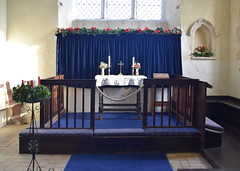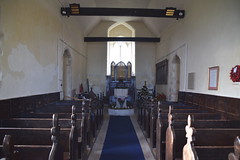| |
|
One of Suffolk's
longest dedications in a parish with the joint shortest
name. Even more than that, this is one of the most
sparsely populated parishes in the entire county, with
barely twenty people living in it. Not surprisingly, Hoo
church was threatened with redundancy in the 1970s, but
has ridden that storm to survive today, with regular
services in conjunction with the church at Charsfield, a
mile or so off, with which Hoo has long formed a joint
ecclesiastical parish.
The tower is 16th century red brick, the top a rather
harsh modern restoration, and is most singular. If it
looks familiar, it might be because this was the church
in the film Akenfield. Although the book was
based on neighbouring Charsfield, the graveyard of the
church there was too small to allow for filming.
Despite this building not being particularly historically
significant, there is something very special about it.
Come here on an afternoon in winter, with the shadows
creeping in across the fields. Gaze out southwards across
the gentle valley, with Charsfield tower peeping through
the mist below. Or on a sunny day in late spring, with
the hedgerows all about burgeoning with flowers and
birdsong.
St Andrew and St Eustachius is remote in the fields, with
only Hoo Hall and the old rectory for company. And there
can be few plainer, simpler Suffolk interiors than this.
As is common in east Suffolk, the nave and chancel run
together form a tunnel-like effect, opening out into the
light of the large east window. There is no coloured
glass. The furnishings are similarly simple and homely,
and all in all the effect is of the peace of a rustic
space which cannot have changed a great deal since the
Victorian refurbishment. The building seems to rest
easily in this dim quietness, as if the solitude suits
it. You feel that services can only be a distraction from
such serenity.
The dedication is unique, but I am afraid that it is not
authentic. The medieval dedication may have been to St
Eustace, or it may have been that there was a shrine
altar to that minor saint here. After the Reformation,
church dedications fell into disuse. But the 18th Century
saw a renewed interest in history. The modern dedication
arises from a double (possibly triple) error of those
days. Firstly, a misreading of 'St Eustace' by the
antiquarian Browne Willis, working in the records office
at Norwich Cathedral in the 1720s, and a confusion by him
of Hoo in Suffolk with Hoe in Norfolk, where the medieval
church was dedicated to St Andrew. He may have missed the
actual dedication completely, and many of these documents
are now lost. So, he conflated the two saints into an
undeniably attractive and interesting combination. When
the dedications of Anglican parish churches were restored
to them through the enthusiasm of the ecclesiologists in
the 19th century, this was based on the work of these
well-meaning but inaccurate antiquarians, for Willis had
published his results as Parochiale Anglicanuum
in 1733. Some errors were corrected by the 1780s, when
Bacon's Liber Regis was published. But not this
one.
Two delightful idiosyncrasies complement the dedication.
One panel of the otherwise typically East Anglian font
features a standing figure on a shield - who could he be?
Also, the rood loft stairs are in a window embrasure as
at Whepstead, Shottisham, Oakley and elsewhere - but
here, they head westwards rather than eastwards.
I was struck by the number of names on the First World
War roll of honour. How could such a tiny parish have
sent off so many of its young men?
Coming back here in January 2020 I had a vivid memory of
the spring of 2006 when I had last come this way. Out in
the churchyard the birds were in full voice, a warm
breeze ruffling the trees which were coming into leaf. An
old boy was cutting the grass. We got chatting. I told
him about the flooding of the ford at Marlesford, but
that was nearly six miles back, and so I suppose that to
him I might just as well have been talking about
something which had happened on Mars. Suffolk is an
insular county, despite its proximity to London. But its
people are almost always quietly friendly, and this
little church is open to strangers and pilgrims every
day. And, indeed, there's no other real reason for coming
here.
Simon
Knott, February 2020
Follow these journeys as they happen at Last Of England
Twitter.
  
  
Amazon commission helps cover the running
costs of this site
|
|
|

